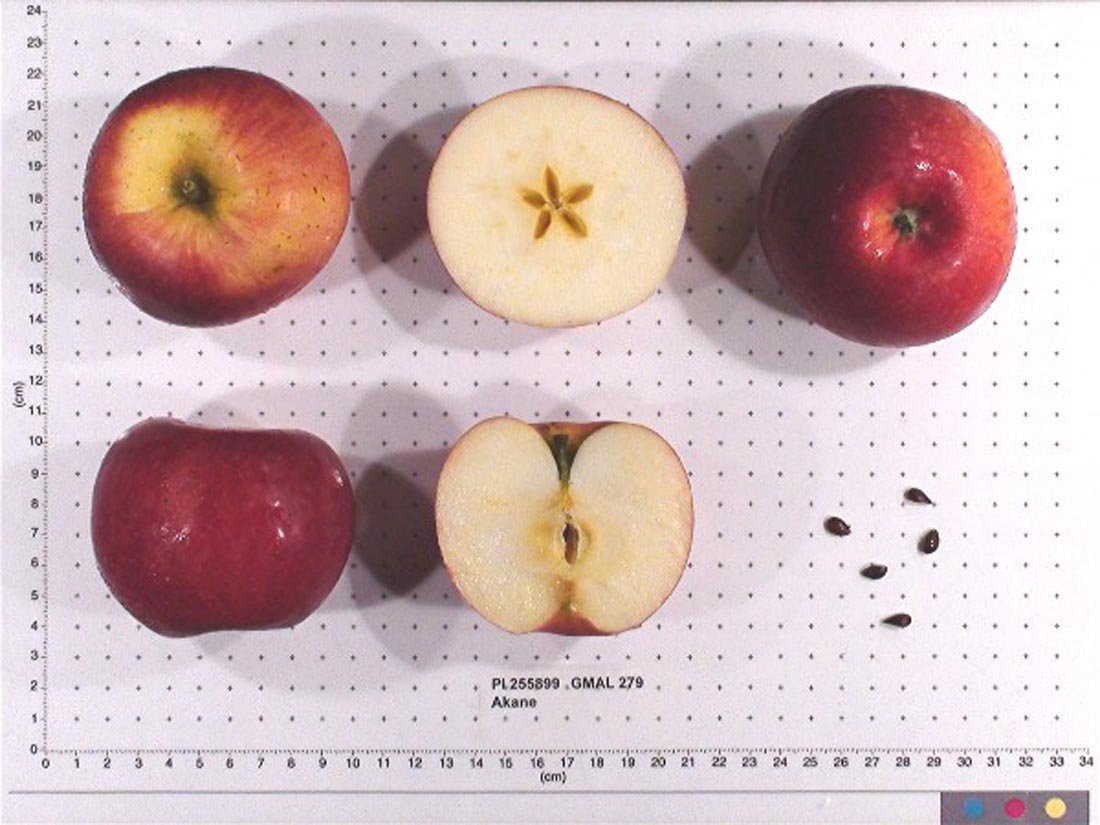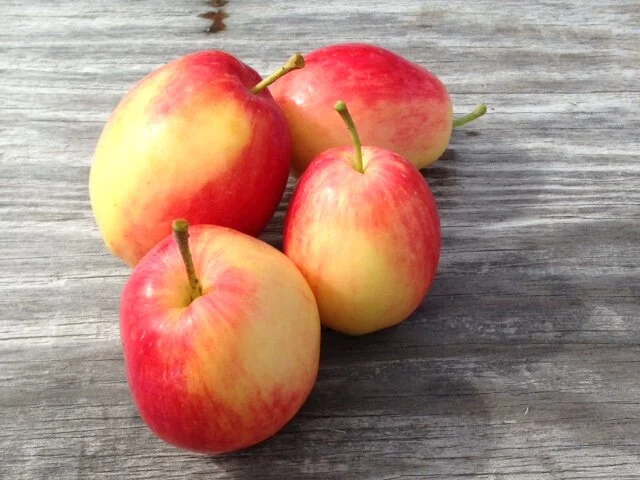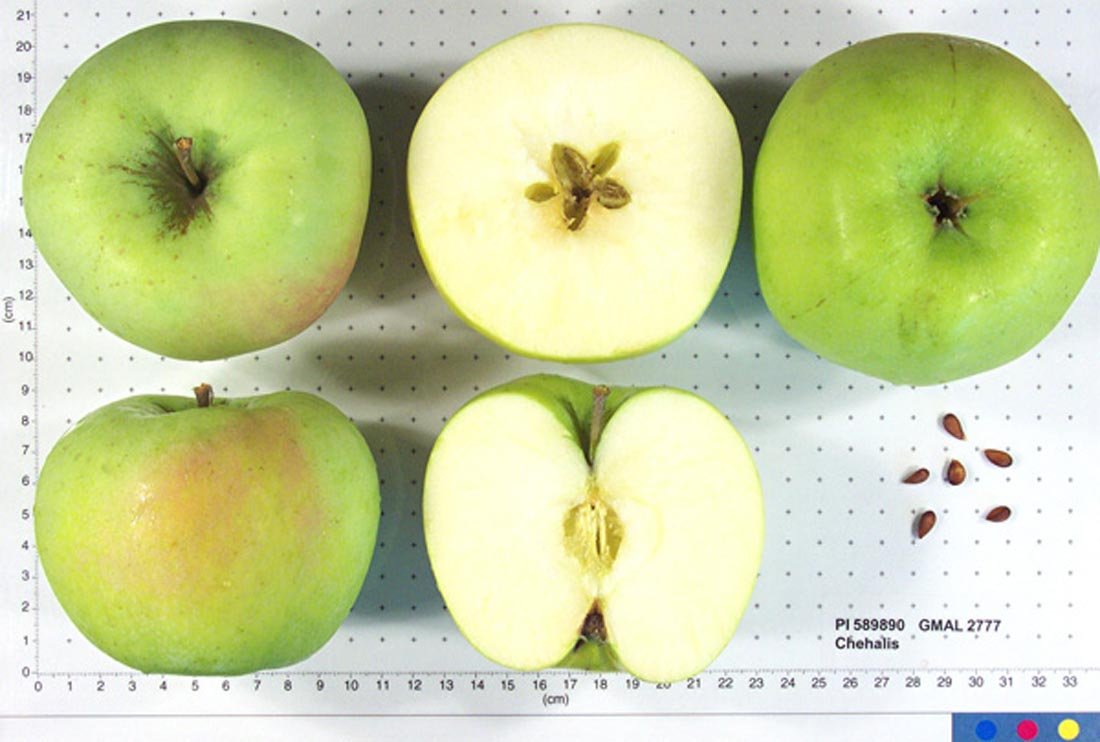Apple Scionwood
Welcome to our collection of apple scionwood. We grow over 130 varieties of apples and offer scions for grafting from most of them.
For filtered search - we have apples organized by categories and tags. Use the filter below to select as many categories and tags as you want to narrow down your search. For the most specific results, select just one category and multiple desired tags. Full functionality is coming soon - we are continuing to update each variety with all the correct categories and tags. Feel free to reach out with questions about specific varieties.
Categories:
Cider apples (good for hard ciders)
Dessert apples (also known as snacking apples, good for fresh eating)
Baking/saucing apples (also known as culinary apples, good for canning, preserving, baking, and cooking)
Red Flesh (red or pink flesh on the inside)
Tags:
Cold hardy (good for extreme cold or Northern climates)
Disease-resistant (has moderate to strong resistance to one or more common apple diseases)
Harvest period early, mid, or late
Heat or low-chill tolerant (good for extreme warmer or Southern climates)
Heavy producer
Pollination Groups A through E
Ordering is now open for this season. Order now for shipping between January and April 2025. Questions? Please contact Christina Fordyce at 503-930-8280 or fordycefarminc@gmail.com.
Scion wood is sold by the piece, except for some varieties that are available in bulk quantities of a 20-pack. We always seek to provide sticks that are close to 12” and pencil thickness at the base but every variety grows differently and so thickness varies.
We ship only within the United States. We do not ship internationally. Rootstock does not ship to California.
Return/Refund Policy: We do not offer returns or exchanges on scionwood or rootstock. We have a 30-day return policy on our clippers (must be unused and returned in original packaging. Return label must be requested). If we have made an error on the scionwood variety you have ordered, we will refund or replace the incorrect item. Claims for errors in your order must be presented within 30 days of receipt of your order. Claims must include a picture of the error and sent to us by email at fordycefarminc@gmail.com. Failure to assert claims within 30 days after order receipt renders this warranty null and void.

This apple was developed in Japan in the mid-1900s - also known as Tohoku 3. These red apples are on the smaller side but packed with flavor when harvested just right. They hang well on the tree so it’s best to harvest as late as possible for enhanced flavor. They don’t keep as long in cold storage so are best for eating right away. Great for fresh eating, this apple is also fantastic in sauces, pies, and dried. Late harvest period.
Note: this apple scionwood is harvested from Fordyce Farm inc. that we operate in Salem, OR. Fordyce Farm inc. is not certified organic.
Categories: dessert apple, baking/saucing apple
Tags: Disease-resistant, Harvest period mid, Pollination Group D

This apple originated in the Ukraine in the 1700s. It made it’s way to the U.S. in the 1800s and over the Oregon trail to Oregon in the mid-1800s among the first named varieties brought here. It’s a lovely and tasty apple that has a fair amount of disease resistance. Ours grow in an non irrigated part of the orchard and survived hot dry summers with ease. Generally they produce only enough for our use so we don’t often stock scionwood for these.

This late August apple is disease resistant, productive and vigorous. A 1930s German apple has Cox Orange Pippin and the Duchess of Oldenburg as its parents. It’s an apple with a margarita trapped inside. It’s so juicy it drips down your chin and yet it’s still firm. It’s so refreshing with its limeade flavor.
Categories: cider apple, dessert apple, baking/saucing apple
Tags: Heat/low-chill tolerant, Disease-resistant, Heavy producer, Harvest period mid, Pollination Group B

Red-fleshed, dark red skin these apples are in high demand from both chefs and canners. These have the flavors of raspberries and blackberries in them and are relatively tart. These ripen in mid-August and have the best disease resistance of our red-fleshed apples. We have had relatively good success grafting these but not 100% success. Scion pieces tend to be slightly skinnier than a pencil.
Categories: Red Flesh, dessert apple, cider apple, baking/saucing apple
Tags: Disease-resistant, Harvest period early, Pollination Group D

Ambrosia are a sweet, late season apple. They are quite susceptible to scab. When added to fresh cider, even in amounts as low as 10% they give a lovely creamy consistency. The came out of British Columbia in the 1990s.
Categories: dessert apple
Tags: Harvest period late, Pollination Group D

From Gloucester, England and the 1700s. Rowan Jacobson describes the flavor of these as “like a tart homemade lemonade.” He suggests you wait until December to eat these but that depends entirely on how much you like tartness in an apple. These highly russetted apples are reasonably disease resistant. The trees are both productive and vigorous. The scion from them tend to be thicker than a pencil.
Categories: dessert apple, cider apple, baking/saucing apple
Tags: Disease-resistant, Harvest period late, Pollination Group D

This is an old American variety from the 1750s and Massachusetts. It’s a flavorful apple that is also fairly disease resistant and reasonably productive. It was a very popular apple in New England until a terrible freeze in the 1930s wiped out many of the trees. We’ve found this apple to be very resilient in the Pacific Northwest. The scion wood is average and we’ve had great success grafting this apple.
Categories: dessert apple, cider apple
Tags: Disease resistant, Heavy producer, Harvest period late, Pollination Group D

From the Netherlands of the 1850s. We’re super fans of these apples. They start out tart but age into a true nutty but intensely apple flavor. These also make a fantastic single varietal hard cider. The trees are productive and highly disease resistant. They are vigorous growers and graft easily. The apples are fantastic eaten fresh, baked or fermented. We think these should be on every homestead and in every commercial orchard.
Categories: dessert apple, cider apple, baking/saucing apple
Tags: Disease-resistant, Heavy producer, Cold hardy, Harvest period mid, Pollination Group C

Originally found as a wild seedling in Switzerland in the 1880s. This is a good, medium sized dessert apple. Yellowish green under a deep red. This variety can tend to be biennial. Responds well to pruning.
Categories: baking/saucing apple, dessert apple
Tags: Harvest period late, Pollination Group D

A pretty apple with cream yellow background and a nice rosy blush. We love this southern apple for its natural resistance to the fungal diseases that injure apples easily in the Willamette Valley. These sweet fruity apples are a favorite on the farm and with the specialty grocers in Portland. These apples are one of our favorites for combining beauty and flavor. These are early apples and usually ripen here in mid-August. We’ve had good success grafting these apples. The blossoms are resistant to a late frost.
Categories: dessert apple
Tags: Disease-resistant, Southern US roots, Harvest period early, Heat/low-chill tolerant, Pollination Group C

From 1740 England. We love their intense flavor, nuttiness and bit of spice. In England these are popular for apple charlotte. It is one of the parents of the legendary Cox Orange Pippin. These produce every other year but their apples are almost always perfect. They resist all the fungal diseases here. We’ve had success grafting them. They are a very late apples, among the last to ripen in our orchard.
Categories: dessert apple, baking/saucing apple
Tags: Disease-resistant, Heavy producer, Harvest period late, Pollination Group D

These are out of New England in the late 1700s. They have a powdery blue bloom. Their unique flavor has been described as tropical. Henry David Thoreau listed them as a favorite cultivated apple, being more like the wild ones. These have some disease resistance, are late season apples and fairly vigorous growers.
Categories: dessert apple, baking/saucing apple
Tags: Cold hardy, Harvest period late, Pollination Group C

Firm, very late season apple that will survive temperatures as low as 26 degrees and just get sweeter. Commercial apples from the 1950s and New Zealand. Very scab prone in wet conditions.
Categories: dessert apple, baking/saucing apple
Tags: Harvest period late, Pollination Group E

Queener Farm has only offered Cameo apple scionwood for a couple years. For years the trees had been too scab infected to produce marketable fruit and lacked vigor. After the farm switched to a nutrient based program, they responded with gusto. The apples were near perfect and the trees thrived and grew. They also handled the “heat dome” of 2020 with temperatures reaching 115 remarkably well. They had no protection and experienced minimal sunburn and no bitterpit response. If you are in an area with little scab or you have a program for dealing with it these can be a lovely addition to your orchard.
Categories: dessert apple, baking/saucing apple
Tags: Harvest period mid, Pollination Group A

Since other Centennial Crab apples are not sweet and ours are very sweet we have considered renaming these Sweet Centennial Crabs. These seem slightly larger and yellower than the ones elsewhere as well. These are little plum shaped fruits with rose blush over pale yellow. These are slow growing trees that seem to stay small even on larger growing rootstock. They are challenging to graft and their growth patterns are unique among the apples in our orchard. However, we’ve found them to be well worth the trouble. They are lovely, delicious, disease resistant and consistent producers.
Categories: dessert apple
Tags: Disease-resistant, Harvest period early, Pollination Group A

These originated in the 1930s from a seedling of a Golden Delicious raised by Lloyd Lonburg of Oakville, WA - so these are a PNW native! They bruise easily, so handle them with care! Great for fresh eating and pies. Lasts about 2 months in cold storage.
Note: this apple scionwood is harvested from Fordyce Farm inc. that we operate in Salem, OR. Fordyce Farm inc. is not certified organic.
Categories: dessert apple, baking/saucing apple
Tags: Disease-resistant, Heavy producer, Harvest period early, Pollination Group D

These apples look and taste a little quince like. They are coveted for cooking but are also tasty as a sliced up dessert apple paired with a nice cheese. They hold reasonably well and so you can display them in a bowl for a while before eating them. These tend to ripen over several weeks. We pick them from early August into September. They have decent disease resistance and are productive every year. Excess heat can make them drop their fruit early. We’ve found them quite easy to graft.
Categories: dessert apple, baking/saucing apple
Tags: Harvest period early, Pollination Group D

A modern apple from Germany, this is a cross of three of our other apples, Cox Orange Pippin, Duchess of Oldenburg and Golden Delicious. It doesn’t look like any of them, being more pointed than all of them with a creamy background and some rose red striping. It’s odd that this apple has as mild a flavor as it does and that, unlike its parents, grows well in hotter, drier climates. The scion wood tends to be skinnier than most.
Categories: dessert apple
Tags: Heat/low-chill tolerant, Harvest period late, Pollination Group D

From Cornwall and introduced in 1813. They are noted for the aromatic flavor that contains a hint of clove. The word Gilliflower comes from the French word for clove.
Categories: Dessert apple
Tags: Harvest period mid, Pollination Group D, Heat/low-chill tolerant

From Geneva, New York 1898. It was bred by S.A. Bach, the author of the famous “Apples of New York.” It may be unfamiliar but it’s actually the 15th most commonly sold apple in the U.S. While these grow well in the eastern part of the country we find them to be slow growers, modest producers and not exceptional in any way. The scion is minimal and not likely to be very long or thick.
Categories: dessert apple
Tags: Pollination Group C, Disease-resistant, Harvest period mid, Cold hardy

A lovely round apple with a slight orange cast. Introduced in 1825, it’s considered the benchmark for apple flavor. They are notoriously disease prone but we've found they are easier to get nice apples from than many others with little disease resistance.
Categories: dessert apple, cider apple, baking/saucing apple
Tags: Heavy producer, Harvest period mid, Pollination Group C
Airlie Red Flesh
Akane
Alexander (Aporte)
Alkmene
Almata, (red flesh)
Ambrosia
Amere de Berthecourt
Anna
Arkansas Black
Ashmead's Kernel
Baldwin
Belle de Boskoop
Berner Rosen
Blairmont
Blenheim Orange
Blue Pearmain
Braeburn
Bramley Seedling
Calville Blanc d'Hiver
Cameo
Centennial
Chehalis
Coles Quince
Corail (Pinova & Pinata)
Cornish Gillflower
Cortland
Cox's Orange Pippin
Dabinett
Devonshire Crimson Queen
Discovery
Dolgo
Duchess of Oldenberg
Dumelow's Seedling
Empire
Enterprise
Egremont Russet
Erwin Bauer
Esopus Spitzenberg
Fiesta
Foxwhelp/Fauxwhelp
Fuji - jubilee
Fuji - yataka
Gala
Giant Russian Crab
Gingergold
Glockenapfel
Gold Rush
Golden Delicious
Golden Noble
Granny Smith
Gravenstein
Grimes Golden
Hauer Pippin
Hawkeye
Herefordshire Redstreak
Hidden Rose, (red flesh)
Holstein
Honeycrisp
Hubbardston Nonsuch
Jonagold
Jonathan
Karmijn de Sonnaville
Kerr Crab
King of Tompkins
Kingston Black
Knobbed Russet
Lady
Lady Williams
Laxton Superb
Liberty
Lodi
Lubsk Queen
Lyman's Large Summer
Major Apple
McIntosh
Melrose
Mollie’s Delicious
Monark
Mother
Muscadet de Dieppe
Mutsu
Newtown Pippin
Niedzwetzkyana (red flesh)
Northern Spy
Opalescent
Oriole
Orleans Reinette
Parentene
Peasgood Nonsuch
Pierce Pasture
Pink Pearl
Porter’s Perfection
Queen Bee
Queen Cox
Queener Donut
Red Gravenstein
Red Spy
Redfree
Reverend W. Wilkes
Ribston Pippin
Rubinette
Rusty Coat
Sansa
Scarlet Surprise
Sekai Ichi
Senshu
St. Edmunds Pippin
Starr
Summer Rambo
Sundance
Suncrisp
Surprise
Sweet Delicious
Tremblett's Bitter
Washed Russet
Whitney crab
Wickson
Williams Pride
Winter Red Flesh
Wynoochee Early
Yarlington Mill
Yellow Bellflower
York
Zabergau Reinette
20 oz.


These are sold under the trade marked names of Hidden Rose and Mountain Rose. The original tree was found in the Airlie area of the Willamette Valley of Oregon. They are quite productive and vigorous but somewhat scab prone. These are more pink than red inside with nice pale green skin.
Categories: Red Flesh, dessert apple, cider apple
Tags: Heavy producer, Harvest period late, Pollination Group D